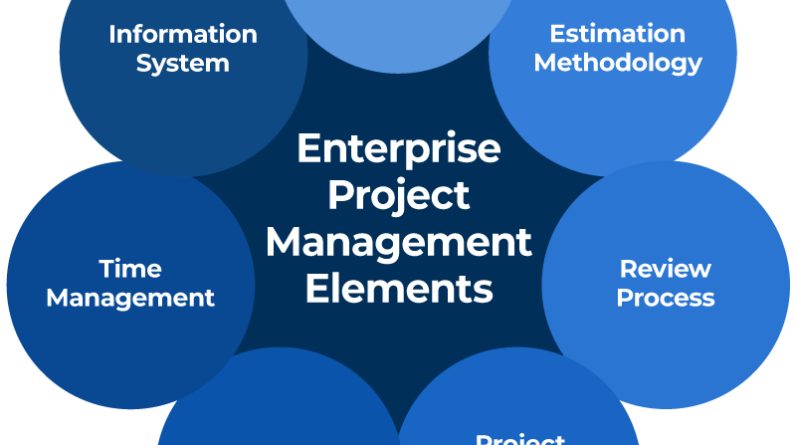
Imagine having a thorough understanding of Enterprise Project Management and how it can transform the way businesses operate. In this article, you will gain valuable insights into the world of Enterprise Project Management, discovering its significance and the benefits it offers to organizations of all sizes. Unravel what it truly means to implement this approach, and how it can effectively streamline project execution, enhance collaboration, and drive long-term success. So, let’s embark on this journey of understanding Enterprise Project Management together and unveil its vast potential for businesses like yours.
What is Enterprise Project Management
Enterprise Project Management (EPM) refers to the strategic handling of projects within an organization that span across departments, business units, and even geographical locations. It focuses on managing large-scale and complex projects that require coordination and collaboration among various stakeholders. Unlike traditional project management, which typically involves managing individual projects, EPM takes a holistic approach to managing the entire project portfolio and aligning it with the organization’s overall strategic goals.
EPM involves the integration of people, processes, and technology to ensure the successful planning, execution, and completion of projects. It aims to optimize resources, enhance communication and collaboration, and improve decision-making throughout the project lifecycle. By implementing proper EPM practices, organizations can achieve better project outcomes, increase efficiency, and drive successful business results.
Benefits of Enterprise Project Management
Improved project execution
One of the main benefits of EPM is improved project execution. By adopting standardized project management processes and methodologies, organizations can ensure consistency and quality in project delivery. EPM provides a structured framework for defining project objectives, developing detailed plans, tracking progress, and managing risks and issues. This leads to better project control, reduced delays, and increased project success rates.
Enhanced resource management
Another key advantage of EPM is enhanced resource management. EPM enables organizations to optimize the allocation of resources by centrally managing and prioritizing project demands. It helps facilitate resource capacity planning, identify resource conflicts, and ensure that resources are effectively utilized across projects. This leads to improved resource productivity, reduced resource bottlenecks, and better overall resource management.
Increased collaboration
Collaboration is a fundamental aspect of EPM. It encourages cross-functional teams, departments, and stakeholders to work together towards a common objective. EPM provides platforms and tools for effective communication, knowledge sharing, and collaboration. By fostering collaboration, organizations can enhance teamwork, streamline decision-making processes, and boost project performance.
Better decision-making
EPM enables better decision-making by providing real-time visibility into project status, progress, and performance. Through the use of dashboards and reports, project stakeholders can access up-to-date information on key project metrics, milestones, and risks. This enables informed decision-making, facilitates proactive risk management, and allows for timely interventions to address project issues and challenges.

Key Elements of Enterprise Project Management
Project portfolio management
Project portfolio management (PPM) is a critical element of EPM. It involves the centralized management of an organization’s projects, programs, and initiatives. PPM helps align project investments with strategic goals, prioritize projects based on their business value, and optimize resource allocation. It provides a clear overview of the entire project portfolio, enabling better decision-making and resource management.
Resource management
Effective resource management is essential in EPM. It involves identifying, allocating, and optimizing resources to ensure successful project execution. Resource management in EPM includes activities such as resource planning, capacity management, and resource leveling. By efficiently managing resources, organizations can prevent resource bottlenecks, optimize resource utilization, and improve overall project performance.
Risk management
Risk management is a crucial component of EPM. It involves identifying, assessing, and mitigating risks throughout the project lifecycle. EPM facilitates the establishment of risk management processes, tools, and methodologies to proactively identify and manage project risks. By effectively managing risks, organizations can minimize the impact of potential threats, increase project success rates, and prevent costly project failures.
Change management
Change management is an integral part of EPM. It involves managing the changes that occur during the project lifecycle, including changes in project scope, requirements, and schedule. EPM helps organizations establish change management processes and procedures to ensure that changes are properly assessed, approved, and implemented. By effectively managing and controlling changes, organizations can minimize project disruptions, maintain project alignment with strategic goals, and maximize project success.
Implementing Enterprise Project Management
Assessing organizational readiness
Before implementing EPM, it is essential to assess the organizational readiness for change. This involves evaluating the organization’s current project management capabilities, culture, and readiness to adopt new processes and methodologies. By conducting a thorough assessment, organizations can identify gaps and determine the necessary steps and resources required for successful EPM implementation.
Developing a project management office (PMO)
Establishing a project management office (PMO) is a key step in implementing EPM. The PMO serves as a centralized authority for project management practices, methodologies, and governance. It provides guidance, support, and oversight to project managers and teams. The PMO ensures consistency, standardization, and continuous improvement in project management processes across the organization.
Choosing the right tools and technology
Selecting the appropriate tools and technology is crucial for effective EPM implementation. Organizations should consider their specific needs, such as project tracking, resource management, and collaboration, when choosing EPM software tools. The selected tools should align with the organization’s project management processes and support its overall project management goals.
Defining project governance structure
Establishing a project governance structure is essential for successful EPM implementation. This involves defining roles, responsibilities, and decision-making authority within the organization. Clear governance structures ensure accountability, promote effective communication, and provide a framework for managing risks and resolving issues. By defining a project governance structure, organizations can ensure that projects are well-managed and aligned with strategic objectives.

Popular Enterprise Project Management Methodologies
Agile
Agile is an iterative and incremental project management methodology that focuses on flexibility and adaptability. It emphasizes collaboration, customer involvement, and rapid delivery of high-quality outputs. Agile methodologies, such as Scrum and Kanban, are well-suited for complex and dynamic projects where requirements may change frequently.
Waterfall
Waterfall is a traditional project management methodology that follows a sequential and linear approach. It involves distinct phases, such as requirements gathering, design, development, testing, and implementation. Waterfall methodologies are suitable for projects with well-defined and stable requirements.
Scrum
Scrum is a subset of Agile and is characterized by short, time-boxed iterations known as sprints. It emphasizes self-organizing and cross-functional teams, frequent feedback, and continuous improvement. Scrum is particularly effective for projects with rapidly changing requirements and a high degree of collaboration.
Kanban
Kanban is a visual project management methodology that focuses on workflow visualization and continuous improvement. It involves visualizing project tasks on a Kanban board and using work-in-progress limits to optimize throughput. Kanban is suitable for projects that require real-time visibility into project status and progress.
Role of the Project Manager in Enterprise Project Management
Leadership and decision-making
In EPM, project managers play a critical role in providing leadership and making informed decisions. Project managers are responsible for setting clear project objectives, establishing project plans, and defining project success criteria. They must possess strong leadership skills to guide project teams and stakeholders through the project lifecycle and ensure the achievement of project goals.
Communication and stakeholder management
Effective communication and stakeholder management are key responsibilities of project managers in EPM. Project managers must ensure that project stakeholders are well-informed, engaged, and aligned with project objectives. They need to establish communication channels, facilitate regular project meetings, and manage stakeholder expectations to ensure successful project execution.
Risk and issue management
Project managers in EPM are responsible for identifying, assessing, and managing project risks and issues. They need to develop risk management strategies, implement risk mitigation measures, and monitor project risks throughout the project lifecycle. Addressing project issues and risks in a timely manner is crucial to ensure project success.
Managing project resources
Project managers are responsible for effectively managing project resources in EPM. This involves resource planning, allocation, and utilization to ensure that projects are adequately resourced. Project managers must monitor resource availability, address resource conflicts, and make resource adjustments as needed to maintain project timelines and deliverables.

Challenges in Implementing Enterprise Project Management
Resistance to change
Implementing EPM often requires significant changes in project management processes, methods, and tools. Resistance to change from project teams, stakeholders, and other organizational members can pose a challenge. It is important to address resistance through effective change management strategies, stakeholder engagement, and communication.
Lack of executive support
EPM implementation requires strong executive support and sponsorship. Without the support of senior management, it can be challenging to secure the necessary resources, overcome organizational barriers, and drive change. Organizations need to ensure that executives understand the value of EPM and are actively involved in its implementation.
Lack of project management skills
EPM requires project managers and team members with comprehensive project management skills and knowledge. However, organizations may face challenges in finding and developing skilled project management professionals. Investing in training and development programs can help build the necessary project management capabilities.
Limited resources
Implementing EPM can be resource-intensive, requiring investments in tools, technology, and infrastructure. Limited financial and human resources can pose challenges in rolling out EPM initiatives. Organizations need to carefully plan and allocate resources to ensure successful EPM implementation.
Best Practices in Enterprise Project Management
Establishing clear project objectives
Clear project objectives are essential for successful EPM implementation. Organizations should ensure that project objectives are well-defined, specific, measurable, achievable, relevant, and time-bound (SMART). Clear objectives provide a clear direction for the project and enable effective project planning and execution.
Regular project monitoring and reporting
Regular project monitoring and reporting are crucial in EPM. Organizations should establish mechanisms for monitoring project progress, tracking key performance indicators, and collecting project data. Regular reporting enables informed decision-making, identifies potential issues, and allows for timely corrective actions.
Continuous improvement and lessons learned
Continuous improvement is a fundamental principle in EPM. Organizations should foster a culture of continuous learning and improvement. Project teams should regularly review project outcomes, identify lessons learned, and apply them to future projects. Continuous improvement helps drive project success and increases organizational project management maturity.
Building a collaborative project culture
Building a collaborative project culture is essential in EPM. Organizations should promote collaboration, knowledge sharing, and teamwork among project teams and stakeholders. Effective communication, transparency, and trust are essential for creating a collaborative environment that fosters innovation, creativity, and project success.
Enterprise Project Management Software Tools
Microsoft Project
Microsoft Project is a popular EPM software tool that provides comprehensive project management capabilities. It offers features such as project planning, scheduling, resource management, and reporting. Microsoft Project allows for the centralized management of projects, facilitates collaboration among project teams, and provides real-time project visibility.
Oracle Primavera P6
Oracle Primavera P6 is a widely used EPM software tool designed for managing large-scale and complex projects. It offers robust project planning, scheduling, and resource management features. Oracle Primavera P6 enables organizations to optimize project portfolios, track project progress, and manage project risks.
Asana
Asana is a cloud-based EPM software tool that focuses on task management and collaboration. It allows project teams to create and assign tasks, track progress, and communicate effectively. Asana provides features such as task dependencies, project timelines, and real-time project updates.
JIRA
JIRA is an agile project management tool commonly used in software development projects. It facilitates project planning, issue tracking, and collaboration. JIRA provides features such as backlog management, sprint planning, and agile reporting. It helps Agile project teams manage their projects effectively and deliver high-quality outputs.
Conclusion
Enterprise Project Management (EPM) is a strategic approach to managing projects within an organization. By adopting EPM practices, organizations can improve project execution, enhance resource management, increase collaboration, and drive better decision-making. The key elements of EPM include project portfolio management, resource management, risk management, and change management. Implementing EPM involves assessing organizational readiness, developing a project management office (PMO), selecting the right tools, and defining a project governance structure. Popular EPM methodologies include Agile, Waterfall, Scrum, and Kanban. The project manager plays a crucial role in EPM, providing leadership, managing communication, addressing risks and issues, and managing project resources. Challenges in implementing EPM include resistance to change, lack of executive support, lack of project management skills, and limited resources. Best practices in EPM include establishing clear project objectives, regular project monitoring and reporting, continuous improvement, and building a collaborative project culture. There are various EPM software tools available, such as Microsoft Project, Oracle Primavera P6, Asana, and JIRA, to support effective project management. By embracing EPM and leveraging the right tools and methodologies, organizations can drive successful project outcomes and achieve their strategic objectives.







